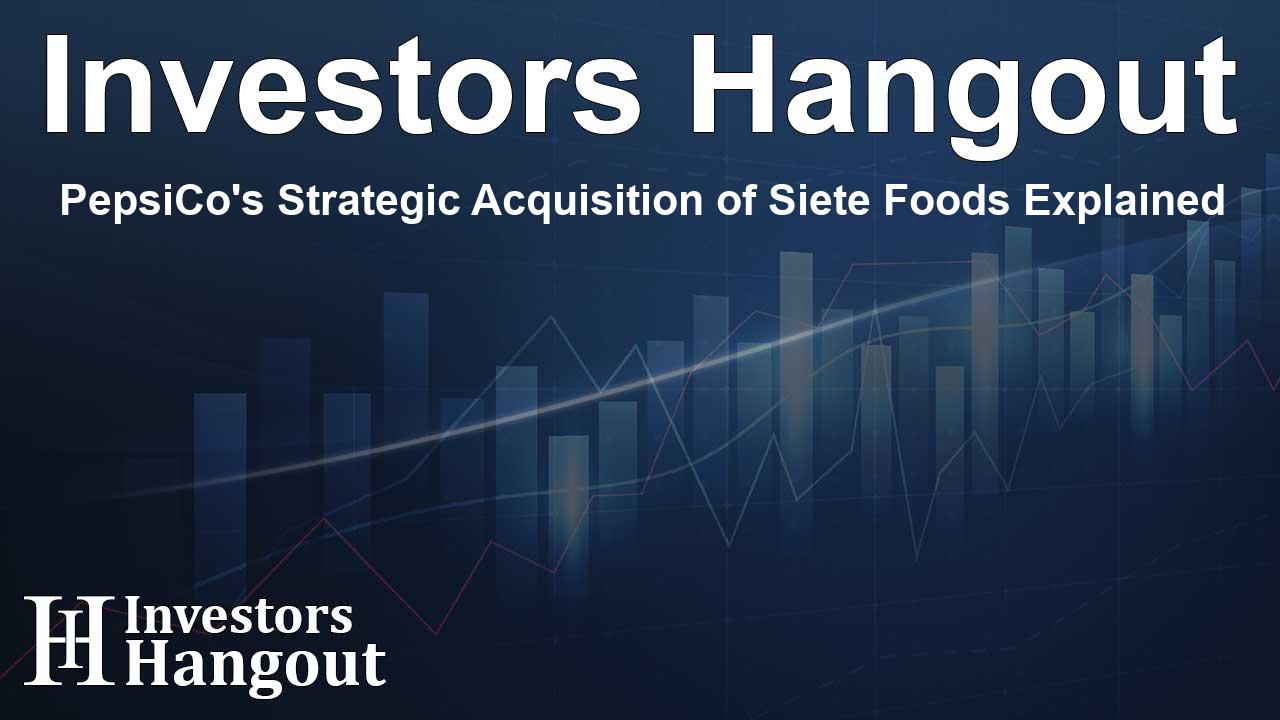PepsiCo's Strategic Acquisition of Siete Foods Explained

PepsiCo and its Diverse Brand Portfolio
PepsiCo (NASDAQ: PEP) is not just a household name known primarily for beverages but stands as a leading food conglomerate. While it has popular soda products like Pepsi, its portfolio extends much further, incorporating snacks through the Frito-Lay brand, ready-to-eat meals from Quaker Oats, and sports drinks like Gatorade. The vast reach of its products is evident, with brands available in over 200 countries and territories globally. With a market capitalization of approximately $230 billion and revenues hitting around $91.5 billion in recent times, PepsiCo's scale is impressive.
Understanding the Financial Attractiveness of PepsiCo
While investors continue to regard PepsiCo favorably, it appears to be more attractive country-wise from a valuation standpoint. Historical metrics show that PepsiCo's price-to-sales, price-to-earnings, and price-to-cash flow ratios currently sit below their historical averages. Additionally, the company offers a dividend yield of 3.2%, which is significantly higher than the consumer staples sector average of 2.6%. This positioning signifies that PepsiCo is fairly priced, if not slightly undervalued, providing a compelling option for dividend investors.
Insights into PepsiCo's Acquisition of Siete Brands
PepsiCo's recent announcement of acquiring Siete Foods for $1.2 billion may not have generated significant buzz on Wall Street, reflecting its minimal immediate financial dilution, given Siete's estimated revenues of around $500 million. With such numbers, the acquisition represents less than 1% of PepsiCo’s overall revenues. The acquisition, however, is strategically vital. Priced attractively at about 2.4 times sales, this initiative seems sustainable and poses no major risk to PepsiCo's financial stability.
The Strategic Value Behind This Acquisition
Historically, PepsiCo has thrived on strategic acquisitions. Companies like Gatorade were crafted through similar strategies, acquiring brands that were already positioned to succeed within their specific markets. The addition of Siete allows PepsiCo to push further into Mexican-American cuisine, enhancing not only its salty snack segment but also its portfolio in sauces, seasonings, and other food items.
Enhancing PepsiCo's Market Reach
Siete's offerings align well with PepsiCo’s existing products, enabling the beverage giant to leverage its robust marketing and distribution networks to boost Siete's presence. Such acquisitions solidify PepsiCo’s dominance within the salty snack sector, ensuring the company remains competitive, particularly in a diversifying dietary landscape.
Reviewing the Impact of the Acquisition
While the acquisition of Siete might seem like a minor transaction at first glance, its future implications cannot be overlooked. For long-term investors and dividend seekers, this acquisition extends beyond immediate revenue impacts and embodies the continuous growth strategy that PepsiCo has embraced over the decades. Not only does it represent an opportunity for PepsiCo to diversify its offerings further, but it also signals to shareholders that the company is committed to expanding its reach.
Exploring Future Opportunities with PepsiCo
For potential investors, seeking opportunities in well-established companies like PepsiCo can be akin to catching a wave before it crests. With a strategy of consistent growth, brands such as Siete set the stage for future expansion for PepsiCo, while investors ride along with the momentum of a resilient and adaptive company.
Frequently Asked Questions
1. What are the primary products of PepsiCo?
PepsiCo offers a diverse range of products, including beverages like Pepsi and Gatorade, snacks from Frito-Lay, and meals through Quaker Oats, among others.
2. Why did PepsiCo acquire Siete Foods?
The acquisition is strategic for expanding PepsiCo’s reach into Mexican-American cuisine and enhances its snack portfolio.
3. How does the Siete acquisition affect PepsiCo's financial status?
It is a modest financial transaction that poses little risk and potentially enhances PepsiCo's long-term growth and market share.
4. What makes PepsiCo attractive to dividend investors?
PepsiCo has a solid dividend yield of 3.2% and has increased its dividends annually for over 50 years, enhancing its appeal to investors.
5. Where can I find PepsiCo products?
PepsiCo products are available in more than 200 countries and territories, making them easily accessible to consumers worldwide.
About The Author
Contact Thomas Cooper privately here. Or send an email with ATTN: Thomas Cooper as the subject to contact@investorshangout.com.
About Investors Hangout
Investors Hangout is a leading online stock forum for financial discussion and learning, offering a wide range of free tools and resources. It draws in traders of all levels, who exchange market knowledge, investigate trading tactics, and keep an eye on industry developments in real time. Featuring financial articles, stock message boards, quotes, charts, company profiles, and live news updates. Through cooperative learning and a wealth of informational resources, it helps users from novices creating their first portfolios to experts honing their techniques. Join Investors Hangout today: https://investorshangout.com/
The content of this article is based on factual, publicly available information and does not represent legal, financial, or investment advice. Investors Hangout does not offer financial advice, and the author is not a licensed financial advisor. Consult a qualified advisor before making any financial or investment decisions based on this article. This article should not be considered advice to purchase, sell, or hold any securities or other investments. If any of the material provided here is inaccurate, please contact us for corrections.
